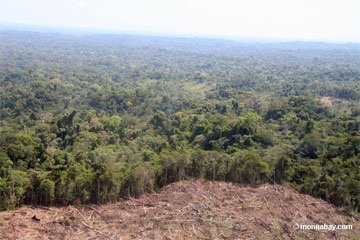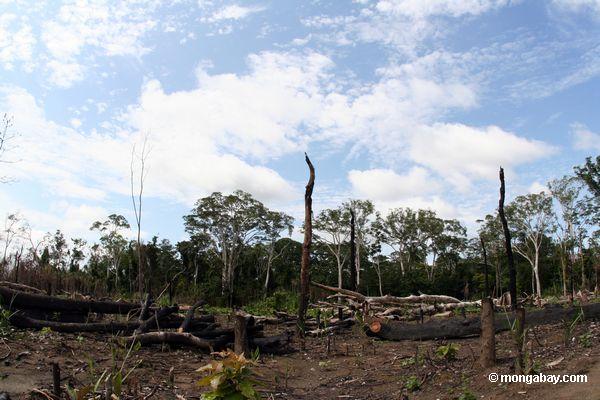Global deforestation rates fall, but area the size of Panama still disppaears each year
Rhett A. Butler, mongabay.com
November 14, 2005
FAO figures called inaccurate and misleading |
Net deforestation rates have fallen, but some 13 million hectares of the world’s forests are still lost each year according to a new report from the Food and Agriculture Organization of the United Nations (FAO).
The FAO Global Forest Resources Assessment 2005 (FRA 2005) found that annual net loss of forest area between 2000 and 2005 was 7.3 million hectares/year — an area about the size of Sierra Leone or Panama — down from an estimated 8.9 million ha/yr between 1990 and 2000. This is equivalent to a net loss of 0.18 percent of the world’s forests annually.
Forests now cover nearly 4 billion hectares or 30 percent of the world’s land area, however 10 countries account for two-thirds of all forest area: Australia, Brazil, Canada, China, the Democratic Republic of the Congo, India, Indonesia, Peru, the Russian Federation and the United States of America.
South America suffered the largest net loss of forests between 2000 and 2005 – around 4.3 million hectares per year – followed by Africa, which lost 4.0 million hectares annually.
 Deforestation in Peru. |
Oceania had a net loss of 356 000 ha/year in 2000-2005, while North and Central America together had a net loss of 333 000 ha/yr. Asia moved from a net loss of around 800 000 ha per year in the 1990s to a net gain of one million hectares per year between 2000 and 2005, primarily as a result of large-scale afforestation reported by China. Forest areas in Europe continued to expand, although at a slower rate than in the 1990s.
Primary forests — that is forests with no visible signs of past or present human activities — account for 36 percent of total forest area, but are being lost or modified at a rate of 6 million hectares a year through deforestation or selective logging.
FRA 2005 also found that new forests and trees are being planted at increasing rates, but plantations still account for less than 5 percent of forest area, it notes.
From biological diversity to carbon sequestration
Forests have multiple functions, including conservation of biological diversity, soil and water, supplying wood and non-wood products, providing recreation opportunities and serving as carbon sinks.
While most forests are managed for multiple uses, FRA 2005 found that 11 percent are designated principally for the conservation of biological diversity — and such areas have increased by an estimated 96 million hectares since 1990.
Around 348 million hectares of forests are used to conserve soil and water, control avalanches and desertification, stabilize sand dunes and protect coastal areas.
One-third of the world’s forests are mainly used for production of wood, fibre and non-wood products, and more than half have production of these products as one of their management objectives, indicating the importance of forest products at the local, national and international levels.
Forests are particularly important as carbon sinks: the amount of carbon stored in forest biomass alone is about 283 Gigatonnes (Gt) of carbon, though it decreased globally by 1.1 Gt annually between 1990 and 2005. Carbon stored in forest biomass, deadwood, litter and soil together is roughly 50 percent more than the amount of carbon in the atmosphere.
A global effort
The data for FRA 2005 was provided to FAO by national governments and resource assessment specialists, with more than 800 people involved in the entire process, including 172 national assessment teams.
FAO figures called inaccurate and misleading
This article is based on a press release from FAO.
